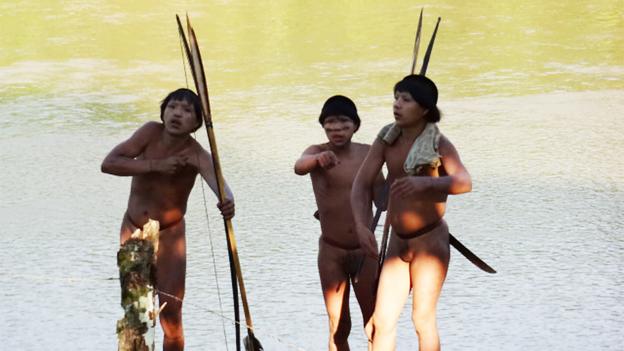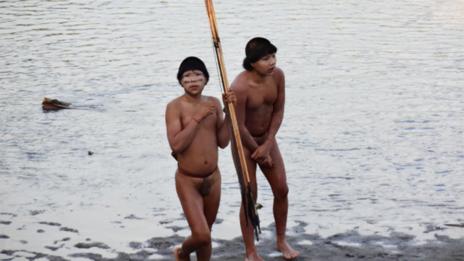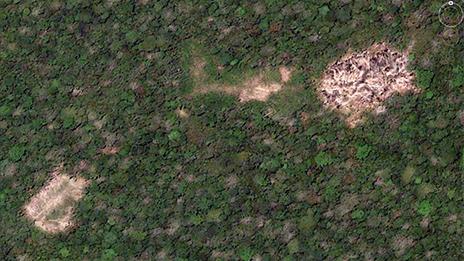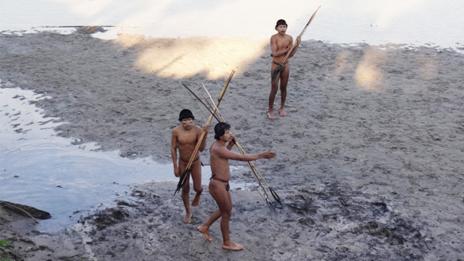
(Funai)
One of the world’s last isolated tribes has apparently emerged from the forest. Rachel Nuwer investigates whether there is anyone left who has never seen the outside world, and discovers that ‘first contacts’ are often cursed by death and disease.
On July 1, Funai, the Brazilian governmental agency in charge of indigenous Indian affairs, quietly posted a short press release on its website: two days earlier, they said, seven members of an isolated Indian tribe emerged from the Amazon and made peaceful contact with people in a village near the Peruvian border.
As the first official contact with such a tribe since 1996, the event was out of the ordinary. But the event itself could have been anticipated. For weeks, local villagers in Brazil’s Acre state had reported sightings of the tribesman, who supposedly came to steal crops, axes and machetes, and who “mimicked monkey cries” that frightened women and children.

Two members of an isolated indigenous tribe from the Amazon investigate a settled community of villagers in Acre, Brazil (Funai)
The Indians’ decision to make contact was not driven by a desire for material goods, however, but by fear. With the help of translators who spoke a closely related indigenous Panoan language, the Acre Indians explained that “violent attacks” by outsiders had driven them from the forest. Later, details emerged that their elder relatives were massacred, and their houses set on fire. Illegal loggers and cocaine traffickers in Peru, where the Indians are thought to come from, are likely to blame, according to the Brazilian government. Indeed, Funai’s own nearby monitoring post was shut down in 2011 due to increasing escalations with drug traffickers.
Early contact with the Acre tribe, recorded by Funai
After they decided the situation called for drastic measures, the Indians did not just stumble upon the Brazilian village by chance – they probably knew exactly where to go. “They know far more about the outside world than most people think,” says Fiona Watson, research director for the non-profit organisation Survival International. “They are experts at living in the forest and are well aware of the presence of outsiders.”
This gets to the heart of a common misconception surrounding isolated tribes such as the one in Acre: that they live in a bubble of wilderness, somehow missing the fact that their small corner of the world is in fact part of a much greater whole – and one that is dominated by other humans. “Almost all human communities have been in some contact with one another for as long as we have historical or archaeological records,” says Alex Golub, an anthropologist at the University of Hawaii at Manoa. “Human prehistory is not like that game Civilization where you start with a little hut and the whole map is black.”
Fear factor
Today’s so-called uncontacted people all have a history of contact, whether from past exploitation or simply seeing a plane flying overhead. The vast majority of an estimated 100 or more isolated tribes live in Brazil, but others can be found in Colombia, Ecuador, Peru and northern Paraguay. Outside of the Americas, isolated groups live in Papua New Guinea and on North Sentinel Island of India’s Andaman Islands, the latter of which is home to what experts think is the most isolated tribe in the world, the Sentinelese. Nothing is known about their language, and Indian authorities have only rough estimates of how many of them exist today. But even the Sentinelese have had occasional brushes with other societies; members of their tribe have been kidnapped, helicopters sometimes fly over their island and they have killed fishermen who have ventured too close.

A member of the Yora tribe from the border between Bolivia and Peru - 1986 (Kim Hill)
It is almost always fear that motivates such hostilities and keeps isolated groups from making contact. In past centuries and even decades, isolated tribes were often murdered and enslaved by outsiders. From the time white Europeans first arrived in the Americas, indigenous peoples learned to fear them, and passed that message down generations through oral histories. “People have this romanticised view that isolated tribes have chosen to keep away from the modern, evil world,” says Kim Hill, an anthropologist at Arizona State University. But when Hill and others interview people who recently came out of isolation, the same story emerges time and time again: they were interested in making contact with the outside world, but they were too afraid to do so. As Hill puts it: “There is no such thing as a group that remains in isolation because they think it’s cool to not have contact with anyone else on the planet.”
Some have personal memories of traumatic encounters with outsiders. In the 1960s and 70s, Brazil largely viewed the Amazon as an empty place in need of development. Indigenous people who stood in the way of that progress were given little or no warning before their homes were bulldozed over – or they were simply killed. In one case in Brazil’s Rondônia state, a single man, often referred to as “the Last of His Tribe,” remains in a patch of forest surrounded by cattle ranches. His people were likely killed by ranchers years ago. When he was discovered in 1996, he shot arrows at anyone who dared to approach his home. Funai officials sometimes check up on his house and garden, and, as far as anyone knows, he’s still living there today. “It’s a really sad story of this one little pocket of forest left where this one lone guy lives,” says Robert Walker, an anthropologist at the University of Missouri. “He’s probably completely terrified of the outside world.”

People from Brazil's Guaja tribe (Rob Walker)
In some cases in the 70s and 80s, the Brazilian government did try to establish peaceful contact with indigenous people, often with the aim of forced assimilation or relocation. They set up “attraction posts” – offerings of metal tools and other things indigenous Indians might find to be valuable – to try and lure them out of hiding. This sometimes led to violent altercations, or, more often than not, disease outbreaks. Isolated people have no immunity to some bugs, which have been known to wipe out up to half of a village’s population in a matter of weeks or months. During those years, missionaries traipsing into the jungle also delivered viruses and bacteria along with Bibles, killing the people they meant to save.
In 1987, Sydney Possuelo – then head of Funai’s Department of Unknown Tribes – decided that the current way of doing things was unacceptable. After seeing tribe after tribe demolished by disease, he concluded that isolated people should not be contacted at all. Instead, natural reserves should be placed aside for them to live on, and any contact attempts should be left up to them to initiate. “Isolated people do not manifest among us – they don’t ask anything of us – they live and die mostly without our knowledge,” he says. When we do contact them, he says, they too often share a common fate: “desecration, disease and death.”
Viral event
Unfortunately, history seems to be repeating itself. Three weeks after the Indians in Acre made contact, Funai announced that several of them had contracted the flu. All of them subsequently received treatment and vaccinations, but they soon returned to the forest. The fear, now, is that they will carry the foreign virus back with them to their home, spreading it to others who have no natural immunity.
“It’s hard to say what’s going to happen, other than to make doomsday predictions,” Hill says. “So far, things are looking just like they looked in the past.”
Possuelo – who was fired from Funai in 2006 after a disagreement with his boss over some of these concerns – issues a more direct warning: “What they do in Acre is very worrying: they are going to kill the isolated people,” he says. “The president of Funai and the Head of the Isolated Indians Department should be held accountable for not meeting established standards.” (Funai did not respond to interview requests for this story.)
Surprisingly, no international protocol exists that outlines how to avoid this predicament. “Every government and group involved in making contact just wings it according to their own resources and experiences,” Hill says.
The common problem is a lack of institutional memory. Even in places like Brazil with decades of experience, Hill says, “each new government official takes on the task without knowing much about what happened in the past.” Some officials, he adds, have minimal expertise. “Quasi-amateur is what I’d call them: government officials who come in with no medical, anthropological or epidemiological training.”
Total denial
The situation in Peru, Watson points out, is even worse. “At one stage, the Peruvian government denied that uncontacted people even exist,” she says. And now major oil and gas operations are allowed to operate on reserves containing their villages. Added to that is the presence of illegal loggers and drug traffickers – making for a very crowded forest.

A satellite image of a remote village (Google/Rob Walker)
Native people living there seem to be well aware of these encroachments. Google Earth satellite images that Walker recently analysed reveal that one large isolated village in Peru seems to be migrating, year by year, further afield from outside encroachment on their land, including a planned road project. “Most people argue that what’s going on here is that they’re potentially being forced out of Peru,” he says. “It seems like they are running away.”
When accidental harm from the outside world seems inevitable, Hill argues it would be better if we initiated contact. Slowly building up a long-distance friendship, he explains, and then carrying out a controlled contact meeting with medical personnel on site would be preferable. After that initial contact is made, anthropologists should be prepared to go back into the forest with the group and stay on site to monitor the situation for several months, as well as build up trust and communication. That way, if an epidemic should break out, help can be called for. “You can’t just tell them after 15 minutes, ‘Oh, by the way, if your whole village gets sick, send everyone out to this spot to get medical treatment,’” Hill says. “They won’t comply with that.”
It’s unclear whether or not such a plan is being carried out in Acre, however. “Funai is not the most transparent organisation, and they have complete monopoly on what happens to remote people in Brazil,” Hill says. “Unfortunately, that doesn’t work in the best interest of native peoples.”

Several members of an isolated indigenous tribe from the Amazon (Funai)
To ensure isolated groups have a future, both Brazil and Peru might need to become more transparent as well as more proactive about protecting them. No matter how remote the Amazon might seem, unlike the Sentinelese, South America’s isolated groups do not live on an island cut off from the forces of mainstream society. “Everywhere you look, there are these pressures from mining, logging, narcotrafficking and other external threats,” Walker says. “My worry is that if we have this ‘leave-them-alone’ strategy, at the end of the day the external threats will win. People will just go extinct.”

0 comments:
Post a Comment